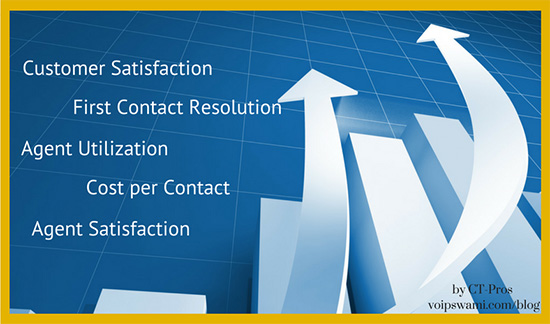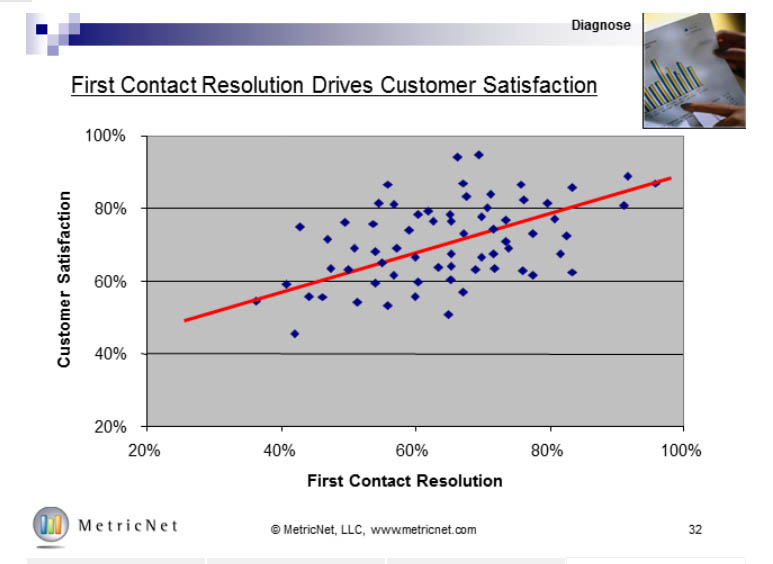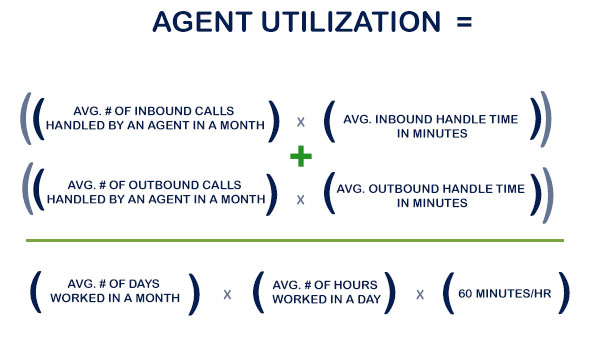
In this article we discuss how self-service IVR (interactive voice response) solutions built on the Summit platform can be used to influence the following five call center operations metrics to your business’s advantage:
• Customer satisfaction
• First Contact Resolution
• Agent utilization
• Cost per contact
• Agent Satisfaction and Performance
Throughout this article, we will be referencing data presented during a recent webinar hosted by MetricNet, a benchmarking and research organization. Although the webinar talked about a wide variety of call center metrics for KPIs, we are going to focus on the five mentioned above in this article and will explain how and why self-service IVRs can impact those KPIs.
Metric #1: Customer Satisfaction
To explain how the use of self service IVRs can impact customer satisfaction, we have to understand that the customer satisfaction metric itself is in fact directly influenced by two other metrics:
1. First contact resolution (FCR)
2. Agent satisfaction
When either of these two factors suffers, meaning they are negatively impacted, customer satisfaction likewise suffers.
To increase customer satisfaction, call centers implement various methods and strategies to improve first contact resolution and agent satisfaction. We will address the former, first contact resolution and how self-service IVRs can contribute to the FCR.
While agent satisfaction is also important, it is indirectly impacted by agent utilization which we discuss later.
By the end of this article, you’ll understand how IVRs can impact these metrics that influence the customer satisfaction KPI.
Metric #2: First Contact Resolution KPI
First contact resolution means that a caller’s inquiry whether a problem, issue, or even a complaint, is resolved to their satisfaction on the first contact with an agent. This means they do not have to be transferred to another agent, nor do they have to call back in at a later time to get a resolution.
Those who experience a first contact resolution exhibit a higher degree of satisfaction than those who do not, as shown in the diagram below.

In fact, we all have probably experienced this at some point or another in our daily lives.
Whether calling a hotline to discuss promotional cable TV upgrade packages, cell phone bundles, or talking to remote technical support, it’s not exactly a pleasant experience when the person we initially speak with can’t answer our questions, doesn’t provide accurate information, or simply can’t fix our problems.
If, however, we call the hot-line and get the answer to our question upon initial contact, regardless of the length of time spent with that initial contact, we are typically very satisfied once the resolution is reached.
We may not say, “Hey I got a first contact resolution, and I’m a satisfied caller,” but that’s exactly what it’s called by those who manage and monitor contact centers metrics, benchmarks, efficiencies, etc.
How Self-Service IVRs Help the FCR
However, if FCR is related to dealing with a live agent as mentioned in the webinar, then what does a self-service IVR have to do with this?
When customers have the ability to call into an IVR and get what they need, when they need it, anytime they want it, the result is still resolution at first contact. The only difference is the first contact is with an IVR solution, not a live call agent.
Perhaps your call center is to handle requests from distributors, wholesalers, or resellers for a product that you produce, and therefore many of your inbound calls are inquiries about the status of order fulfillment, invoice bill payments, or other related information.
If using an IVR, the resolution or answer to the caller’s inquiry is made possible by programming the IVR to provide advanced functionality in the form of self-service that would have otherwise been handled by a live agent whether making a payment, canceling or updating an order and so forth.
If you can increase the number of first contact resolutions, our customer satisfaction metric will also improve.
Metrics #3 and #4: Agent Utilization and Cost Per Contact
Although agent utilization and cost per contact are two separate KPIs, they have a causal relationship, meaning there exists a cause and effect correlation.
In fact, the two are so important that the implications of sacrificing either agent utilization or cost per contact can have direct consequences to the health of a call center. Being able to make certain those metrics are kept at a healthy rate through the use of a self-service IVR is of great importance and worth investigating.
What is Agent Utilization?
Agent utilization represents the percentage that an agent is handling calls and associated work tasks in relation to their overall time at work (PTO, holidays, etc. are taken into account).
The formula to determine the utilization percentage is defined as explained during the webinar. Here's a graphic to illustrate the formula.

In other words, it’s a “measure of actual time worked by agents in a month, divided by total time at work during the month.”
This means that as each agent is tasked with more calls to handle themselves, the utilization percentage increases.
The higher the utilization, the lower the cost per contact because the call center is using less to do more. Fewer agents, but more work per agent.
To lower the utilization rate, the company would need to hire additional staff to lighten the call load per agent, but this means the cost per agent is now increased due to new employee expenses such as payroll, benefits, and training.
Quite the catch-22.

Metric #5: Agent Satisfaction and Performance impacted by Agent Utilization
In addition, according to MetricNet’s benchmarking database and as mentioned in the webinar, when agent utilization is too high for too long, agent performance suffers. Agent performance is an indicator of agent satisfaction. The greater the satisfaction, the better the performance.
Industries where service desks are critical to providing high customer satisfaction levels, the utilization rate should be no higher than the 60-70% range, with 48.4% being the average as discussed in the webinar. Once it hits the 60-70% range and above, turnover increases as a result of burn-out and low morale.
And that’s another catch-22 because the cost of turnover can easily be $10,000.00 per agent according to industry averages.
So, do you increase your agent count thereby increasing the cost per contact, or do you increase the agent utilization which can lead to decreased performance resulting in turn over which also increases operational costs?
Using Self Service IVRs to Improve Agent Utilization and Cost Per Contact
Let's talk about how IVRs can help solve this dilemma. Just as in our example above for FCR, IVRs can be designed to assist the callers in areas where the involvement of a live agent is not required. This lowers the volume of calls agents have to handle, allowing them to avoid burn out, experience greater job satisfaction, and service customers with greater focus and quality.
Therefore, IVRs improve agent utilization without incurring additional cost per contact increases, or experiencing any degradation in agent satisfaction or performance which can impact customer satisfaction.
In summary, it’s a lot to digest. It may seem like an intricate multi-dimensional design made up of dominoes where one metric can impact another metric that is also influenced by yet another. Implementing IVRs adds a new dimension that can directly impact certain key metrics which in turn indirectly influence other metrics in the positive.
By now you should see the value of an IVR, and how it can be an extremely powerful tool for improving contact center management and the customer experience.
Determine Where Your IVR Makes the Most Impact
How you choose to use the IVR depends on your particular needs. Ask yourself what types of questions are frequently asked by callers that could instead be answered through an IVR that’s integrated into a backend system, such as billing, appointment management, shipping systems, accepting payments, and checking order status.
When it comes to any call center or contact center looking to implement strategies that improve any of these five metrics, incorporating the use of self-service IVRs can certainly play a pivotal role.
As Summit programmers, we can build your custom application for you, making sure the goals you want to accomplish are being met. Summit is 100% hosted so not only is your application built directly on the platform, but it will also run on it as well.
Even beyond that, we have our Swami Vision reporting API for IVRs that works alongside Summit, providing you with insight into metrics beyond the scope of your contact center solution.
If you would like to learn more about using IVRs in your business, contact us today, and we’ll be glad to work with you.
Related Articles:
Getting Smart with Business SMS (text messaging) for Improving Customer Experiences
Examples of CPaaS and How Enterprises can Benefit From it
Infographic: CPaaS Examples for Improving Customer Service